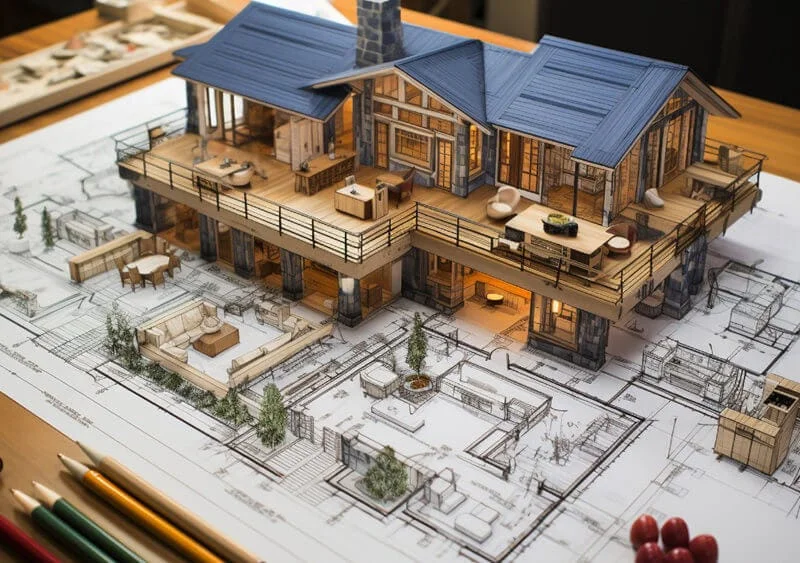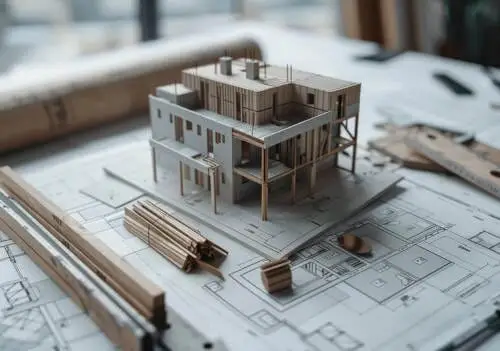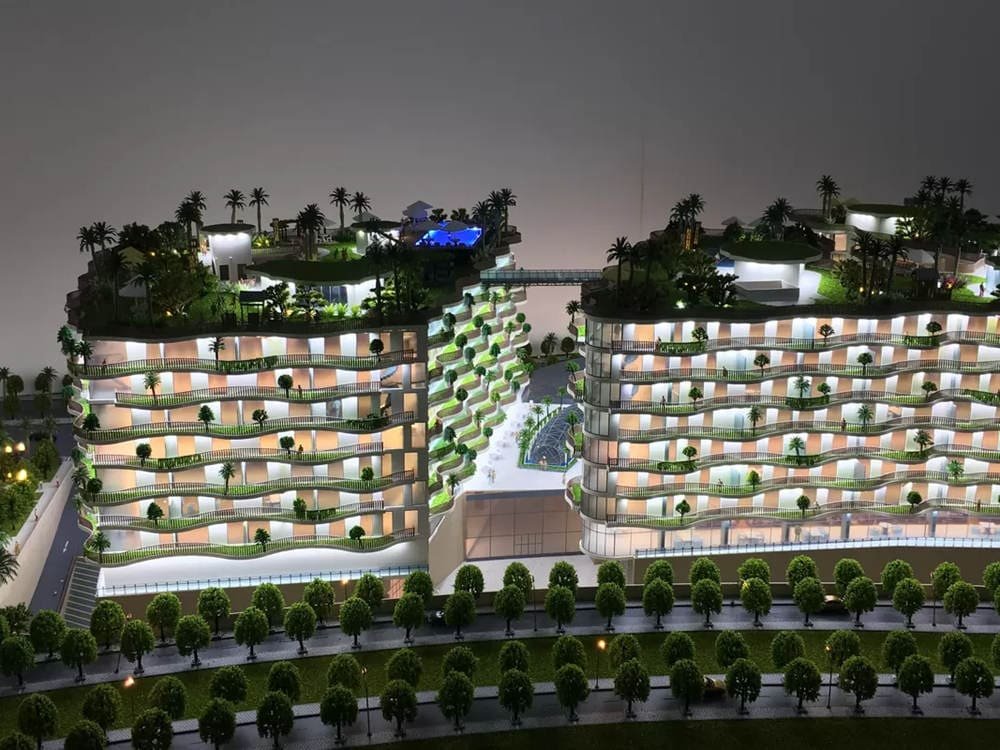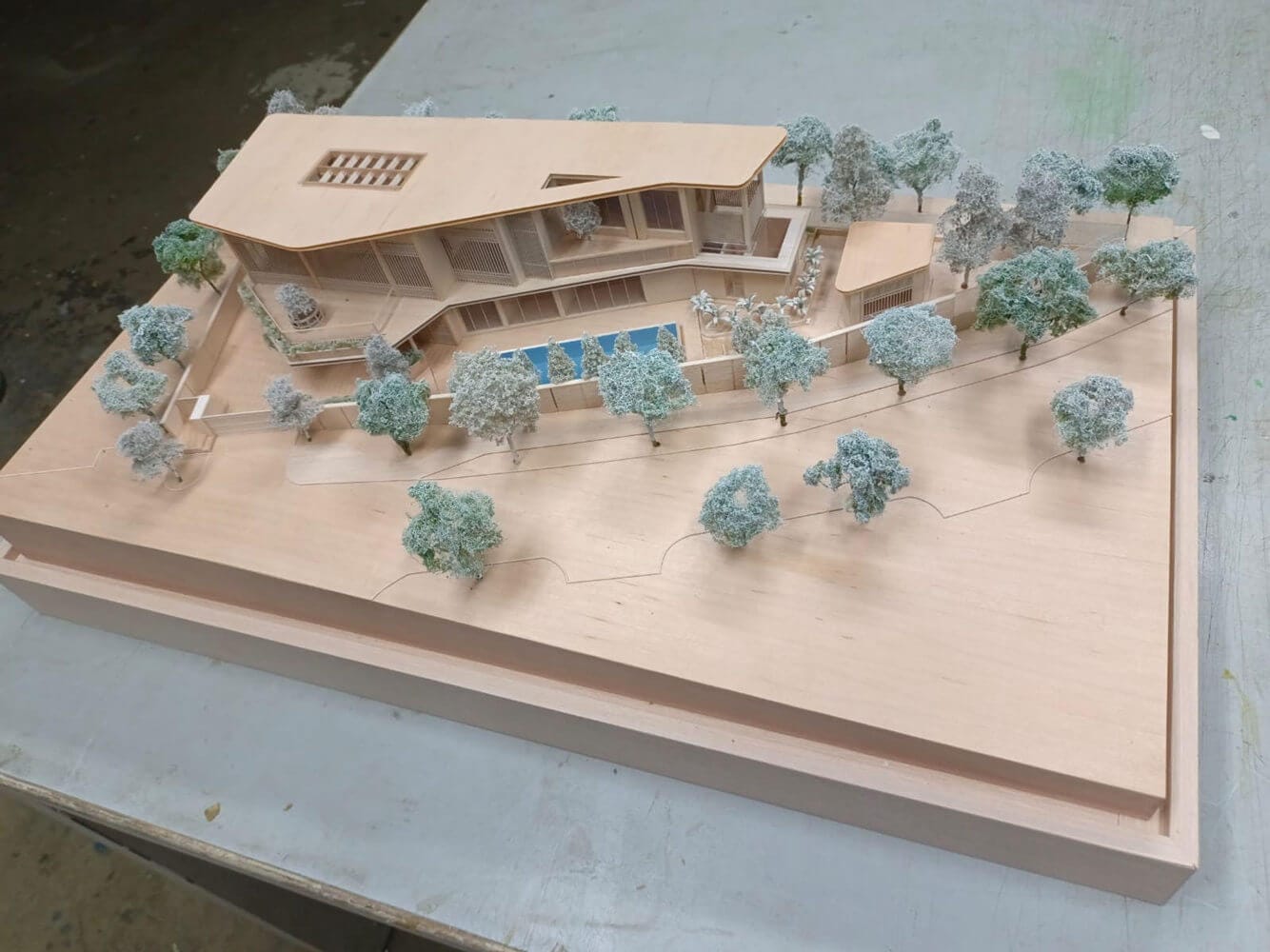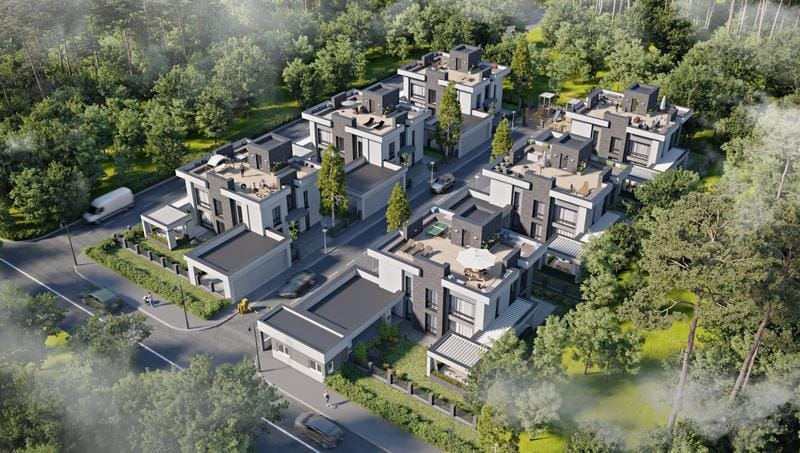In der heutigen Architekturwelt, wo Computerbildschirme mit detaillierten Details gefüllt sind 3D-Renderings, man könnte meinen, handgefertigt Maßstabsmodelle gehören der Vergangenheit an. Überraschenderweise, Diese Miniaturgebäude sind bei vielen Architekten noch sehr lebendig’ Studios. Warum? Denn trotz aller ausgefallenen Technik, Physische Modelle bieten etwas Besonderes, mit dem Computer einfach nicht mithalten können. Sie helfen Architekten beim Nachdenken, Design, und ihre Ideen auf einzigartige Weise kommunizieren.
Seit Jahrhunderten, Architekten haben Modelle verwendet, um ihre Entwürfe zum Leben zu erwecken. Denken Sie an die detaillierten Modelle, die während der Renaissance geschaffen wurden! Heute, diese verkleinerten Versionen von Gebäuden, Stadtlandschaften, oder sogar Innenräume sind weiterhin ein entscheidender Teil des Designprozesses. Es sind nicht nur hübsche Objekte; Es handelt sich um leistungsstarke Werkzeuge, die Architekten dabei helfen, ihre Entwürfe zu verfeinern, Erklären Sie sie den Kunden, und sogar die Finanzierung von Projekten sichern. Let’s explore why these miniature marvels remain so important in the field of architecture.
Inhaltsverzeichnis

The Fundamental Importance of Scale Models for Architects
Why do architects use scale models?
Bridging the Gap Between Concept and Reality
Imagine trying to understand a complex building design just from blueprints. Es ist schwierig! Scale models bring those flat drawings to life. Architects use models as a way to step into their designs, moving from abstract ideas to a tangible object they can hold, examine, and modify. As Beth Mills, Modelshop Director at Squire & Partner, puts it:“Wir nennen uns Modellbauwerkstatt, Aber wir sind eher ein Makerspace, eine voll funktionsfähige Werkstatt, Wir fertigen zwar Architektur- und maßstabsgetreue Modelle, Wir können alles tun, vom Prototyping von Türgriffen und Fensterinstallationen bis hin zu maßgeschneiderten Möbeln für Squire & Inneneinrichtungsteam der Partner.”Dieses Zitat zeigt, wie Modelle dazu beitragen, die Lücke zwischen konzeptionellen Ideen und der physischen Realität des Bauens zu schließen.
Verbesserte Visualisierung und räumliches Verständnis
Modelle zeigen nicht nur, wie ein Gebäude aussehen wird; Sie helfen Architekten, den Raum zu *fühlen*. Durch Halten und Drehen eines Modells, Architekten bekommen ein echtes Gefühl für die Größe eines Gebäudes, Proportionen, und wie verschiedene Teile miteinander in Beziehung stehen. Sie können sehen, wie Sonnenlicht in einen Raum eindringt oder wie eine Treppe verschiedene Ebenen verbindet.- Intuitives Verständnis der Größenordnung: Ein Modell vermittelt sofort die Größe und den Maßstab eines Projekts auf eine Art und Weise, wie es Zeichnungen nicht können. Sie erkennen sofort, wie groß ein Raum ist oder wie hoch ein Gebäude sein wird.
- Raum in drei Dimensionen erleben: Im Gegensatz zu einem Flachbildschirm, Mit einem Modell können Sie das Design umrunden, es aus verschiedenen Blickwinkeln und Perspektiven zu sehen. Dies hilft Architekten zu verstehen, wie sich Menschen durch den Raum bewegen und ihn erleben.
- Licht und Schatten visualisieren: Architekten können ein Modell unter eine Lampe stellen oder es nach draußen bringen, um zu sehen, wie das natürliche Licht zu verschiedenen Tageszeiten mit dem Gebäude interagiert. Dies hilft ihnen, Entscheidungen über die Platzierung von Fenstern und Beschattungsvorrichtungen zu treffen.
Erleichterung der Designentwicklung und -verfeinerung
Models dienen nicht nur der Show; Sie sind Arbeitswerkzeuge. Architects use them to try out different design ideas, quickly testing variations and seeing the results in three dimensions. This hands-on approach often leads to unexpected discoveries and improvements.- Experimentation and Iteration: It’s easy to make changes to a physical model. Architects can swap out parts, add new elements, or adjust proportions, quickly exploring different design options.
- Identifying Design Flaws: Building a model often reveals problems that weren’t obvious on paper or screen. An architect might discover that a corridor is too narrow or that a roofline doesn’t quite work. These discoveries can be made early in the design process, saving time and money later on.
- Problemlösung: The act of building a model forces architects to think through the construction process. Sie müssen herausfinden, wie verschiedene Teile zusammenpassen, was zu praktischeren und baubareren Designs führen kann.
Ein leistungsstarkes Tool für Kommunikation und Zusammenarbeit
Jemandem, der kein Architekt ist, einen komplexen Entwurf zu erklären, kann eine Herausforderung sein. Maßstabsgetreue Modelle machen es viel einfacher. Sie bieten eine gemeinsame visuelle Sprache, die jeder verstehen kann, vom Kunden bis zum Bauarbeiter.- Kundenpräsentationen: Ein gut gemachtes Modell kann unglaublich überzeugend sein. Kunden können das Design sehen und anfassen, Dadurch fühlt es sich realer und aufregender an. Wie der Kunde eines Architekten sagte, “Es ist etwas, ein Modell in der Hand zu halten. Sie müssen nichts erklären. Du verstehst es einfach.”
- Teamzusammenarbeit: Modelle helfen Architekten, Ingenieure, und andere Berater arbeiten effektiver zusammen. Sie bieten einen gemeinsamen Bezugspunkt für Diskussionen, Stellen Sie sicher, dass alle auf dem gleichen Stand sind.
- Öffentliches Engagement: Für große Projekte, Mithilfe von Modellen kann der Öffentlichkeit gezeigt werden, was geplant ist. This helps people understand the project’s impact on their community and can generate support.
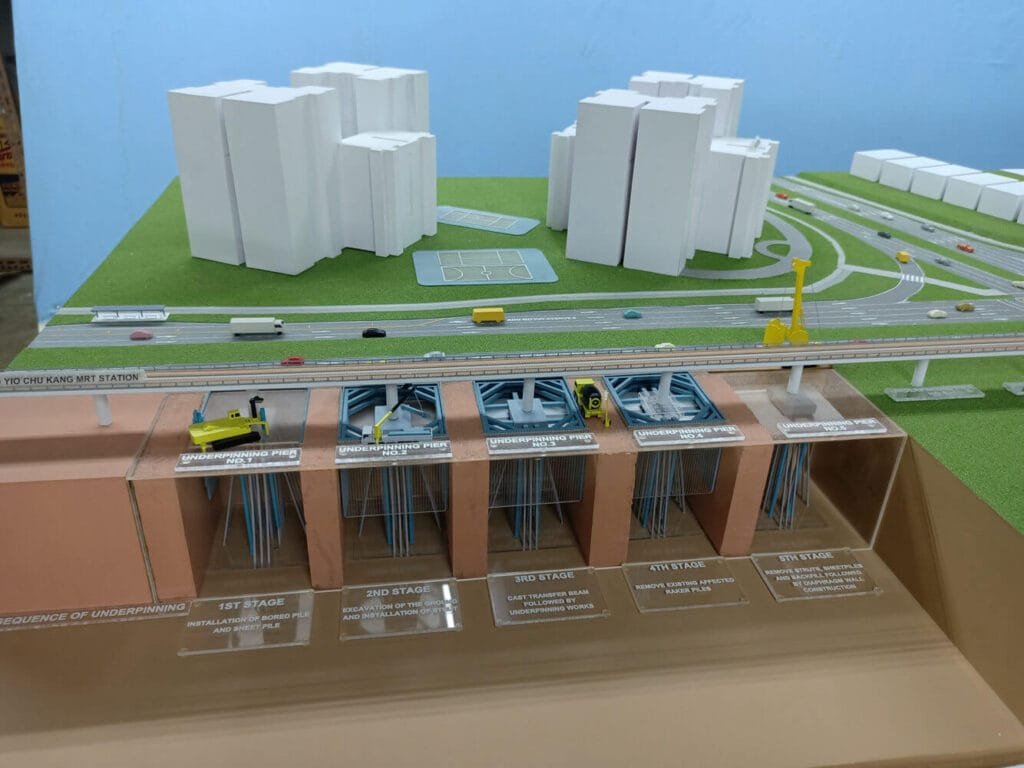
Types of Scale Models and Their Applications
What are the main types of scale models used in architecture?
Konzeptionelle oder massierende Modelle
These are the first models an architect might build. They’re like the rough sketches of the modeling world. Made quickly from simple materials like cardboard or foam, they explore the basic shape, Größe, and arrangement of a building.- Zweck: To quickly test out different ideas and see how they look in three dimensions.
- Eigenschaften: Einfach, Abstrakt, and often lacking in detail.
- Materialien: Karton, Schaum, Balsa Holz.
Arbeits- oder Studienmodelle
As the design develops, architects build more detailed models to study specific aspects of the project. These models help them refine the design, figure out structural details, and solve problems.- Zweck: To analyze and refine the design, Testkonstruktionstechniken, and resolve design challenges.
- Eigenschaften: Detaillierter als massierende Modelle, may include structural elements and some interior features.
- Materialien: Schaumstoffplatte, Holz, Plastik, 3D printed parts.
Präsentationsmodelle
Das sind die Hingucker. Built to impress clients, Investoren, oder die Öffentlichkeit, these models are highly detailed and realistic. They often include landscaping, tiny people, and even working lights.- Zweck: To showcase the final design in a compelling and persuasive way.
- Eigenschaften: Sehr detailliert, realistisch, often includes landscaping, Beleuchtung, and miniature figures.
- Materialien: High-quality materials like wood, Acryl, Metall, and 3D printed components.
Detailmodelle
Manchmal, architects need to focus on a particular part of a building, like a complex facade or an intricate interior space. Detail models are built at a larger scale to examine these elements closely.- Zweck: To study and refine specific design features, such as a unique window design or a complex roof structure.
- Eigenschaften: Larger scale, sehr detailliert, focused on a specific part of the building.
- Materialien: Holz, Plastik, Metall, 3D printed parts.
Stadt- oder Standortmodelle
These models show how a building or development fits into its surroundings. They’re especially useful for large projects or when the relationship between the building and its environment is critical.- Zweck: To visualize the project in its context, understand its impact on the surrounding area, and plan for site development.
- Eigenschaften: Can range from simple block models to highly detailed representations of the site and surrounding buildings.
- Materialien: Karton, Schaum, Holz, Plastik, 3D printed parts.
Innenmodelle
These models focus on the inside of a building, showing the layout of rooms, Möbel, und endet. They help clients understand the interior design and make decisions about materials and furnishings.- Zweck: To visualize and refine the interior design of a building.
- Eigenschaften: Detailed representations of interior spaces, often including furniture, Vorrichtungen, und endet.
- Materialien: Holz, Plastik, Stoff, 3D printed parts.
Hybridmodelle
These models combine the best of both physical and digital worlds. Zum Beispiel, a physical model might have digital projections mapped onto it, or it might be integrated with augmented reality (AR) Technologie.- Zweck: To create interactive and engaging presentations that combine the tangibility of a physical model with the flexibility of digital information.
- Eigenschaften: Combine physical model components with digital projections, AR-Overlays, or other interactive technologies.
- Materialien: Traditional model-making materials combined with digital displays and projection systems.
The Materials and Craft of Model Making
What materials are used to build architectural scale models?
Traditionelle Materialien:
Model makers have a wide array of materials to choose from, each with its own unique properties and uses. Here’s a look at some of the most common ones:| Material | Beschreibung | Vorteile | Nachteile | Gemeinsame Verwendungen |
|---|---|---|---|---|
| Karton | Ein Material auf Papierbasis aus Papierzellstoffschichten. | Kostengünstig, leicht, leicht zu schneiden und zu formen. | Nicht sehr langlebig, anfällig für Feuchtigkeitsschäden. | Konzeptionelle Modelle, Massenstudien, Temporäre Modelle. |
| Schaumstoffbrett | Ein leichtes Material, das aus einem Polystyrolschaumkern besteht, der zwischen Papierschichten oder Kunststoff eingeklemmt ist. | Leicht, leicht zu schneiden und zu formen, relativ günstig, Bietet eine glatte Oberfläche. | Kann leicht verbeugt oder beschädigt werden, nicht so langlebig wie andere Materialien. | Massende Modelle, Studienmodelle, Präsentationsmodelle. |
| Holz | Ein natürliches Material, das geschnitten werden kann, geschnitzt, und in verschiedene Formen geformt. (Balsa, Basswood werden häufig verwendet) | Stark, dauerhaft, kann geschliffen und bemalt werden, um eine Vielzahl von Oberflächen zu erreichen, ästhetisch ansprechend. | Kann teurer sein als andere Materialien, erfordert mehr Fähigkeiten, um mit der Arbeit zu arbeiten. | Präsentationsmodelle, Detailmodelle, Modelle, die ein hohes Maß an Handwerkskunst erfordern. |
| Plastik | Ein synthetisches Material, das geformt werden kann, extrudiert, oder in verschiedene Formen gegossen. (Styrol, Acryl sind häufig) | Dauerhaft, wasserfest, kann transparent oder undurchsichtig sein, Erhältlich in verschiedenen Farben und Texturen. | Kann schwieriger zu schneiden und zu formen sein als andere Materialien, Möglicherweise erfordern spezielle Klebstoffe. | Präsentationsmodelle, Detailmodelle, Modelle, die Transparenz oder spezifische Oberflächenbewegungen erfordern. |
| Ton | Ein Naturtalent, erdiges Material, das durch Trocknen oder Schießen geformt und geformt werden kann, wenn sie nass und verhärtet werden. | Leicht formbar, kann verwendet werden, um organische Formen und Texturen zu erstellen, kostengünstig. | Kann beim Trocken zerbrechlich sein, erfordert Geschicklichkeit, um mit zu arbeiten. | Konzeptionelle Modelle, Studienmodelle, Skulptionsdetails. |
| Metall | Ein starker, langlebiges Material, das geschnitten werden kann, gebogen, und in verschiedene Formen verschweißt. | Extrem langlebig, Kann verwendet werden, um komplizierte Details zu erstellen, ästhetisch ansprechend. | Kann teuer sein, erfordert spezielle Werkzeuge und Fähigkeiten, mit denen man arbeiten kann. | Detailmodelle, Strukturelemente, Modelle, die ein hohes Maß an Präzision und Haltbarkeit erfordern. |
The Role of Adhesives and Finishing Techniques
Building a model is not just about cutting and shaping materials; it’s also about joining them together securely and adding the finishing touches that bring the model to life.- Klebstoffe: Die Wahl des richtigen Klebers ist entscheidend.
- PVA -Kleber: A good all-around choice for paper, Karton, und Holz. It dries clear and is relatively strong.
- Superklebe (Cyanacrylat): Ideal for bonding plastics and metals. It creates a very strong bond almost instantly but can be brittle.
- Sprühklebstoffe: Useful for attaching large, flat surfaces, like applying a paper facade to a foam board backing.
- Heißkleber: Quick and easy for temporary bonds or for attaching lightweight elements.
- Finishing Techniques: These make a model look polished and professional.
- Schleifen: Smoothing rough edges and creating seamless joints.
- Malerei: Adding color and realism to the model. Different types of paint (Acrylfarben, Emails) are used depending on the material being painted.
- Texturierung: Creating realistic surfaces like brickwork, Beton, or vegetation using specialized paints, powders, oder andere Materialien.
- Weathering: Making a model look aged or worn, which can be useful for historical projects or to add a sense of realism.
What tools are used in architectural model making?
Schneidwerkzeuge
Precision cutting is fundamental to model making. Architects and model makers use a variety of tools to achieve clean, accurate cuts:- Handwerksmesser: These are the workhorses of model making, used for cutting paper, Karton, Schaumstoffplatte, and thin plastics. They come with replaceable blades to maintain sharpness.
- Skalpelle: Used for very fine and detailed work, such as cutting out small windows or intricate patterns.
- Schere: Useful for cutting paper and thin materials.
- Schneidmatten: Self-healing mats protect the work surface and provide a stable base for cutting. They also help preserve the sharpness of blades.
Messwerkzeuge
Accurate measurements are essential for ensuring that the model is correctly scaled and proportioned.- Herrscher: Metal rulers are preferred for their durability and straight edges.
- Setzen Sie Quadrate: Wird zum Zeichnen und Messen rechter Winkel verwendet.
- Zirkel: Wird zum Zeichnen von Kreisen und Bögen verwendet.
- Prognern: Wird zum Messen und Zeichnenwinkel verwendet.
- Digitale Bremssättel: For precise measurements of small parts and thicknesses.
Advanced Tools:
Die Technologie hat das Modell zur Herstellung des Modells revolutioniert, introducing tools that offer greater precision and efficiency.- Laserschnitt: This technology uses a laser beam to cut intricate designs into a variety of materials, einschließlich Holz, Acryl, und Karton.
- Vorteile: Highly precise, can create very detailed and complex shapes, fast and efficient.
- Uses: Cutting facades, creating intricate patterns, cutting multiple identical parts.
- Material: Sperrholz, Trotec Laser offers a range of laser-cuttable acrylic sheets.
- 3D Druck: This technology builds up objects layer by layer from a digital file.
- Vorteile: Can create complex and organic shapes that would be difficult or impossible to make by hand, allows for rapid prototyping.
- Uses: Creating detailed building components, printing custom parts, making complex massing models.
- Materialien: Various types of plastics (PLA, ABS, Petg), Harze, und sogar Metalle. You can find a wide selection of 3D printing filaments at MatterHackers.
Physische vs. Digitale Modelle: Understanding the Advantages
Why are physical scale models still relevant in the age of digital design?
The Tangible Difference: Tactility and Spatial Intuition
There’s something special about holding a physical object in your hands. It engages your senses in a way that a computer screen can’t.- Taktile Erfahrung: Touching and manipulating a physical model gives you a direct, intuitive understanding of the design. You can feel the weight of the building, the texture of the materials, and the relationships between different parts.
“Die Hand, in Zusammenarbeit mit dem Geist, bleibt ein leistungsstarkes Werkzeug für die Erstellung und das Verständnis.”
- Spatial Intuition: By moving around a physical model, you get a much better sense of the building’s scale and how different spaces relate to each other. This is something that even the best virtual reality experiences struggle to replicate.
Enhanced Client Engagement and Communication
Physical models can be incredibly effective tools for communicating with clients, especially those who aren’t used to reading architectural drawings.- Visuelle Klarheit: A model provides a clear, unambiguous representation of the design that anyone can understand.
- Emotionale Verbindung: Seeing and touching a physical model can create a stronger emotional connection to the project, making clients more invested in the design.
- Feedback and Collaboration: Models facilitate more productive conversations with clients. They can point to specific areas, Fragen stellen, and suggest changes in a very direct way.
A Different Kind of Creativity: The Value of “Making”
The process of building a physical model is a creative act in itself. It’s a different kind of creativity than what you get from working on a computer.- Hands-On Exploration: Working with physical materials forces you to think differently about the design. You have to consider how things will be built, not just how they look on a screen.
“There’s a speed and intuitiveness to creating a massing model, making it easier to explore various design solutions. A ‘wrong’ model can often tell you as much as a ‘right’ one.”
- Unexpected Discoveries: The process of making can lead to happy accidents and new ideas that you might not have come up with otherwise.
Beyond the Screen: Real-World Considerations
Physical models can help architects study aspects of a design that are difficult to simulate accurately on a computer.- Natural Light Studies: By placing a model under a light source, architects can see how sunlight will enter the building and how shadows will be cast at different times of day.
- Materiality: While digital models can simulate materials, they can’t fully replicate the way real materials look and feel in different lighting conditions.

The Impact of Technology on Architectural Model Making
How are technologies like 3D printing and laser cutting used in model making?
Digitale Herstellung: Geschwindigkeit, Präzision, and Complexity
Digital fabrication tools are revolutionizing the way models are built. They allow for levels of detail and complexity that would be incredibly difficult to achieve by hand.- 3D Druck:
- Rapid Prototyping: Architects can quickly print out different versions of a design to test and compare them.
- Complex Shapes: 3D printing can create organic and intricate shapes that would be very challenging to make using traditional methods.
- Custom Parts: Architects can design and print unique components tailored to a specific project.
- Materialien: Common 3D printing materials for architectural models include:
- PLA (Polylactsäure): A biodegradable plastic that’s easy to print and comes in a variety of colors. It’s a good choice for general model making. (Source: All3DP)
- ABS (Acrylnitril Butadiene Styrol): A stronger, more durable plastic that’s often used for functional parts. (Source: Stratasys)
- Harz: Used in SLA and DLP printing, resin produces very high-resolution prints with fine details. It’s often used for presentation models. (Source: Formlabs)
- Laserschnitt:
- Präzisionsschneiden: Laser cutters can cut extremely precise shapes and patterns into a variety of materials.
- Effizienz: They can quickly cut multiple identical parts, saving time and effort.
- Material Vielseitigkeit: Laser cutters can be used on wood, Acryl, Karton, und sogar einige Stoffe.
- Materialien: Common laser cutting materials for architectural models include:
- Acryl: Often used for windows, Fassaden, and other transparent or translucent elements. (Source: Ponoko)
- Sperrholz: A versatile material that can be used for structural elements, Fassaden, und Landschaftsbau. (Source: Inventables)
- Cardstock/Paper: Used for creating textured surfaces, Vegetation, or intricate details. (Source: Cerulean Tides)
The Rise of Hybrid Models: Blending Physical and Digital
The most exciting developments in model making often involve combining physical and digital elements. This creates new possibilities for interaction and visualization.- Projektionsmapping: Projecting digital images onto a physical model can add color, Textur, und sogar Animation. This can be used to show how a building’s facade might change with different lighting conditions or to display information about the project.
- Erweiterte Realität (AR): AR überlagert digitale Informationen mit der realen Welt. By using an AR app, you could view a physical model and see additional digital content, such as 3D animations, data visualizations, or interactive elements.
- Interaktive Modelle: Some models incorporate sensors and electronics that allow them to respond to touch or other inputs. Zum Beispiel, touching a particular part of a model might activate a light display or trigger a video on a nearby screen.
Virtuelle und erweiterte Realität: New Dimensions of Visualization
VR and AR technologies are changing how we experience architectural designs, offering immersive and interactive ways to explore unbuilt spaces.- Virtuelle Realität (VR): VR creates a fully immersive digital environment. By wearing a VR headset, you can “durchgehen” a digital model of a building, getting a sense of scale and space that’s difficult to achieve with traditional models or renderings.
- Erweiterte Realität (AR): AR overlays digital content onto the real world. You could use an AR app to view a digital model of a building superimposed on its actual construction site, allowing you to see how it will fit into its context.
The Future of Scale Models in Architecture
Will physical scale models become obsolete in the future?
The Enduring Value of Tangibility
In a world that’s becoming increasingly digital, Es gibt eine wachsende Wertschätzung für Dinge, die wir berühren und fühlen können. Physische Modelle bieten eine greifbare Verbindung zum Design, mit der digitale Modelle nicht mithalten können.- Emotionale Verbindung: Wenn Sie ein physisches Modell in Ihren Händen halten, kann dies eine starke emotionale Reaktion hervorrufen. Es ist ein anderes Erlebnis, als sich durch ein digitales Rendering zu klicken.
- Intuitives Verständnis: Die taktile Erfahrung der Interaktion mit einem Modell ermöglicht ein intuitives Verständnis des Designs, das sich digital nur schwer reproduzieren lässt.
Verstärkte Integration mit digitalen Technologien
Die Zukunft des Modellbaus wird voraussichtlich eine noch engere Integration mit digitalen Werkzeugen beinhalten. Wir werden weitere Hybridmodelle sehen, die das Beste aus beiden Welten vereinen.- Nahtlose Arbeitsabläufe: Architekten können mühelos zwischen physischen und digitalen Modellen wechseln, jeden für das nutzen, was er am besten kann. Zum Beispiel, Sie könnten ein Modell aus einem digitalen Design in 3D drucken, Verwenden Sie dieses Modell dann für eine Kundenpräsentation, und später in ein AR-Erlebnis integrieren.
- Verbesserte Interaktivität: Zukünftige Modelle könnten über ausgefeiltere Sensoren verfügen, Elektronik, und Digitalanzeigen, Dadurch werden sie noch interaktiver und ansprechender.
Ein Fokus auf Nachhaltigkeit
Da die Architektur- und Designbranche umweltbewusster wird, Der Modellbau muss sich anpassen.- Umweltfreundliche Materialien: Wir werden wahrscheinlich einen verstärkten Einsatz nachhaltiger und recycelter Materialien im Modellbau erleben, wie Bambus, Kork, und Biokaststoff.
- Bambuslabor: Bietet eine Reihe von Bambusprodukten für verschiedene Anwendungen.
- Aus Luft: Erstellt kohlenstoffnegative Materialien, die in Konstruktion und Design verwendet werden können.
- Verantwortliche digitale Praktiken: Architekten müssen sich der Umweltauswirkungen digitaler Werkzeuge bewusst sein, einschließlich des Energieverbrauchs von Rechenzentren und der E-Abfall, die durch weggeworfene Hardware erzeugt wird.
Anhaltende Bedeutung in der Bildung, Kommunikation, und Innovation
Maßstabsgetreue Modelle werden weiterhin unverzichtbare Hilfsmittel für den Unterricht sein, Ideen austauschen, und die Grenzen des Designs verschieben.- Architekturausbildung: Modelle bieten den Schülern praktische Lernerfahrungen, Wir helfen ihnen dabei, räumliches Vorstellungsvermögen und ein Verständnis für Konstruktionsprinzipien zu entwickeln.
- Kundenkommunikation: Sie bleiben ein leistungsstarkes Werkzeug, um Kunden Designs zu erklären und ihre Zustimmung zu gewinnen.
- Öffentliches Engagement: Für Gemeinschaftsprojekte, Modelle können der Öffentlichkeit helfen, neue Entwicklungen zu verstehen und sich darauf einzulassen.
- Kreative Erkundung: Der Akt des Modellbaus wird für Architekten weiterhin eine Quelle der Inspiration und Innovation sein.
Abschluss
Architekturmodelle im Maßstab sind keineswegs veraltete Relikte. Sie sind dynamische Werkzeuge, die weiterhin eine wichtige Rolle im Designprozess spielen. Sie helfen Architekten bei der Visualisierung, verfeinern, und ihre Ideen auf eine Weise kommunizieren, die digitale Tools allein nicht schaffen. Während die Technologie die Art und Weise verändert, wie Modelle hergestellt und verwendet werden, Der grundlegende Wert des physikalischen Modells bleibt bestehen. Seine Fähigkeit, uns greifbar mit dem Design zu verbinden, Die intuitive Ebene stellt sicher, dass es auch in den kommenden Jahren ein wesentlicher Bestandteil des Werkzeugkastens des Architekten bleiben wird.
Der anhaltende Reiz von maßstabsgetreuen Modellen liegt in ihrer einzigartigen Fähigkeit, die Lücke zwischen Vorstellung und Realität zu schließen. Sie verwandeln abstrakte Konzepte in greifbare Formen, Ermöglichen Sie Architekten die Erkundung, verfeinern, und ihre Entwürfe klar und präzise kommunizieren. Da sich die Technologie ständig weiterentwickelt, Die Integration physischer und digitaler Werkzeuge wird zweifellos die Landschaft der Architekturdarstellung neu gestalten. Jedoch, Der grundlegende menschliche Wunsch nach taktilen Erfahrungen und der inhärente Wert der praktischen Gestaltung legen nahe, dass maßstabsgetreue Modelle weiterhin einen besonderen Platz in der Welt der Architektur einnehmen werden.
Was denken Sie über die Rolle von maßstabsgetreuen Modellen in der Architektur?? Haben Sie Erfahrungen gemacht, bei denen ein physisches Modell Ihnen geholfen hat, ein Design besser zu verstehen?? Teilen Sie Ihre Gedanken in den Kommentaren unten mit!


